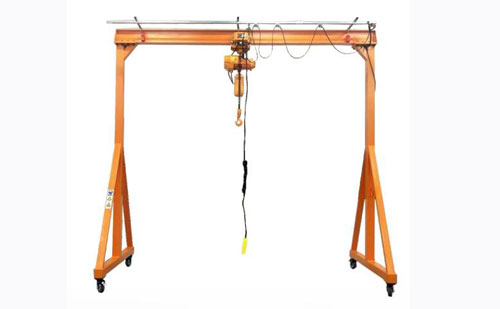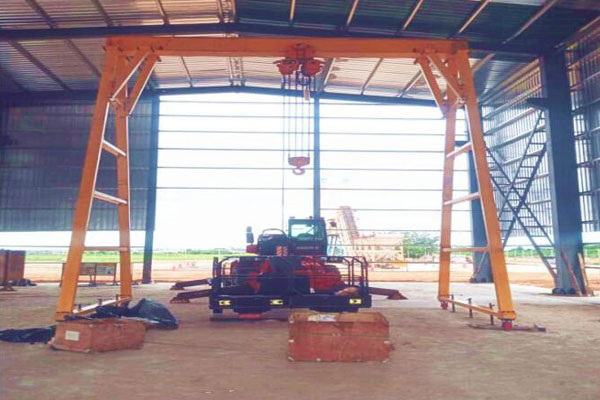Portable Gantry Crane
3 Ton Portable Gantry Crane
Lifting Capacity: 3 ton
Span: m
Lifting Height: m
Working Class:
Note: We can design and manufacture the crane according your requirments and working conditions.
3 Ton Portable Gantry Crane with Electric Hoist for sale:

Types: PT-1 3 Ton Portable Gantry Crane for Sale
- Manual hoist trolley
- Manual crane travelling
- No site limitation
- Standard profile steel
Capacity: 3 ton
Max Height: 10 m
Max Span: 10 m
Hoist Type: Manual chain block with trolley
Crane Travelling: Manual universal wheels

Types: PT-2 3 Ton Portable Gantry Crane for Sale
- Electric hoist with motorized trolley
- Manual crane travelling
- Easy to operate
Capacity: 3 ton
Max Height: 12 m
Max Span: 12 m
Hoist Type: Electric hoist with motorized trolley
Crane Travelling: Manual universal wheels

Types: PT-3 3 Ton Portable Gantry Crane for Sale
- Electric hoist with motorized trolley
- Manual crane travelling
- Electric turning mode
Capacity: 3 ton
Max Height: 12 m
Max Span: 12 m
Hoist Type: Electric hoist with motorized trolley
Crane Travelling: Manual universal wheels

Types: PT-4 3 Ton Portable Gantry Crane for Sale
- Electric hoist with motorized trolley
- Adjustable supporting legs
Capacity: 3 ton
Max Height: 12 m
Max Span: 12 m
Hoist Type: Electric hoist with motorized trolley
Crane Travelling: Manual or motorized universal wheels

Types: PT-5 3 Ton Portable Gantry Crane for Sale
- Electric hoist with motorized
- trolley
- Motorized crane traveling
- Rail-mounted crane traveling
Capacity: 3 ton
Max Height: 10 m
Max Span: 15 m
Hoist Type: Electric hoist with motorized trolley
Crane Travelling: Rail-mounted motorized steel wheels

Types: LT-1 3 Ton Portable Gantry Crane for Sale
- Aluminum alloy structure
- Light weight
- Easy assemble and disassemble
Capacity: 3 ton
Max Height: 8 m
Max Span: 8 m
Hoist Type: Electrical or manual
Crane Travelling: Manual universal wheels

Types: LT-2 3 Ton Portable Gantry Crane for Sale
- Aluminum alloy structure
- Adjustable span
- Light weight
Capacity: 3 ton
Max Height: 8 m
Max Span: 8 m
Hoist Type: Electrical or manual
Crane Travelling: Fixed supporting leg
3 Ton Portable Gantry Crane vs. Fixed Cranes: Which Is Right for You:
Choosing between a 3 on portable gantry crane and a fixed crane depends on several factors related to your specific needs. Here’s a breakdown to help you decide which might be right for you:
1. Flexibility and Mobility
Portable Gantry Crane: As the name suggests, it’s designed to be moved easily. This is ideal if you need to lift loads in multiple locations or require different setups.
Fixed Crane: Once installed, it remains in place. This is better for environments where heavy lifting is routine and space allows for a permanent solution.
2. Capacity and Size
Portable Gantry Crane: Typically has a capacity of around 3 tons, making it suitable for moderate lifting tasks. However, it may not be as robust as larger fixed cranes.
Fixed Crane: Available in a wide range of capacities, including much higher than 3 tons, which is beneficial for heavy industrial applications.
3. Installation and Setup
Portable Gantry Crane: Generally requires minimal setup and can be assembled and disassembled quickly, making it convenient for temporary jobs.
Fixed Crane: Requires significant installation time and expertise. It’s a more permanent fixture, often needing structural considerations.
4. Cost
Portable Gantry Crane: Usually more affordable upfront, both in terms of purchase and installation. Maintenance can also be simpler.
Fixed Crane: Higher initial costs due to installation and infrastructure. However, for high-volume operations, they may offer better long-term value.
5. Space Considerations
Portable Gantry Crane: Ideal for smaller workspaces or sites with varying layouts. They can be moved to where they are needed most.
Fixed Crane: Requires dedicated space, which may limit flexibility if your operations frequently change.
6. Usage Frequency
Portable Gantry Crane: Best for occasional or varied lifting tasks. If your lifting needs change often, this is a solid choice.
Fixed Crane: More suited for continuous, heavy lifting tasks in a dedicated facility.
7. Safety and Regulations
Both types of cranes require adherence to safety standards and regulations, but fixed cranes may have stricter requirements due to their permanent nature.
If you need mobility, lower upfront costs, and flexibility, a 3 ton gantry crane might be the best fit. However, if your operations involve frequent, heavy lifting and you have the space and budget for a permanent solution, a fixed crane could be more beneficial in the long run. Consider your specific lifting needs, workspace, and budget to make the best choice!
Applications of 3 Ton Portable Gantry Crane:
A 3 ton portable gantry crane is a versatile piece of equipment that can be used in various applications across multiple industries. Here are some common uses:- Manufacturing and Assembly: Ideal for lifting heavy components during assembly or manufacturing processes, such as motors, machinery parts, and frames.
- Warehousing: Used to move heavy items around the warehouse, aiding in the loading and unloading of trucks or containers.
- Maintenance and Repair: Commonly found in workshops for lifting engines, transmissions, or other heavy parts during maintenance tasks.
- Construction: Useful for hoisting materials and equipment on construction sites, especially in areas where larger cranes can’t operate.
- Metalworking: Employed in fabrication shops for moving large sheets of metal or finished products.
- Automotive: Perfect for lifting and maneuvering vehicles or parts, such as when working on heavy machinery or custom builds.
- Shipping and Logistics: Assists in loading and unloading heavy cargo, especially in locations without permanent lifting equipment.
- Laboratories: Used for handling large equipment or materials in research facilities where heavy loads need to be moved safely.
Its portability allows for easy relocation and setup, making it a practical choice for both temporary and permanent applications. Always ensure it’s used according to safety guidelines to prevent accidents.
Premium Quality 3 Ton Portable Gantry Crane – Enhance Your Lifting Efficiency:
1. Versatile Mobility
Easy Movement: Designed with wheels for effortless relocation, allowing you to set up lifting operations wherever needed.
Adjustable Height: Many models offer height adjustments, enabling you to tailor the crane for different tasks.
2. Robust Construction
Durable Materials: Made from high-quality steel or aluminum, ensuring strength and stability for safe lifting.
Safety Features: Equipped with safety locks and sturdy support to prevent accidents during operation.
3. User-Friendly Design
Quick Assembly: Most portable gantry cranes can be set up in minutes without the need for specialized tools.
Lightweight Options: Despite their capacity, some models are designed to be lightweight, making them easier to transport.
4. Cost-Effective Solution
Lower Investment: Compared to fixed cranes, portable gantry cranes are more affordable, making them accessible for smaller operations.
Reduced Labor Costs: The efficiency of a portable crane can decrease the time and manpower required for lifting tasks.
5. Ideal for Various Applications
Diverse Uses: Suitable for warehouses, workshops, construction sites, and even home use for lifting heavy equipment or materials.
Multi-Industry Functionality: From manufacturing to automotive, this crane can adapt to various industries, enhancing operational flexibility.
6. Enhanced Productivity
Streamlined Operations: Quick setup and takedown facilitate more efficient workflow, reducing downtime between tasks.
Increased Lifting Capacity: Handles up to 3 tons, allowing you to lift heavier items safely and efficiently.
Previous:1 Ton Portable Gantry Crane


